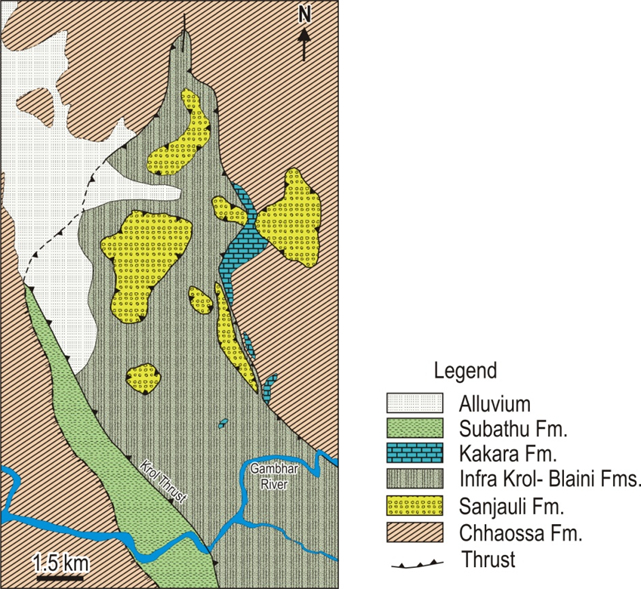Subathu Fm
Type Locality and Naming
The term Subathu was first used by Medlicott (1864) to a group of pre-Siwalik Tertiary rocks occurring in Simla Hill area, after the small town Subathu (Subathoo), southwest of Simla, Himalchal Pradesh. Medlicott's Subathu stage that formed the lowest unit of his "Sub-Himalayan Series" included Subathu, Dagshai and Kasauli stages and the name "Subathu" was restricted to the lower most sequence. Since then, the term Subathu has been in wide usage for designating the Paleocene/Eocene sediments of the Himalayan foothills.
Lithology and Thickness
Claystone and limestone. The Subathu Fm is characterized by olive green-dark grey, splintery shale, dark grey, fossilferous, carbonaceous shale and calcareous shale with bluish-grey to grayish, very hard and compact fossiliferous limestone. Limestones are best developed in the northwestern areas and gradually diminish into the southeast. The characteristic heavy minerals include rutile, zircon and tourmaline. Thickness: Repetition of green and red colored rocks in Lower Tertiary sequence is mainly due to thrusting and faulting due to which calculation exacts formation thick was difficult. The thickness of Subathu Formation however, varies from 180 to 840 m in Himanchal Pradesh, 410 m. at Subathu type area, while in Jammu and Kashmir its thickness ranges from 35 to 225 m.
[Figure: part of Himachal Pradesh geologic map showing relationships among Chhaossa Fm, Sanjauli Fm, InfraKrol Fm, Blaini Fm, Kakara Fm and Subathu Fm (provided by O.N. Bhargava & Birendra Singh)]
Relationships and Distribution
Lower contact
Different views have been expressed on the nature of the base of Subathu from the time of Medlicott (1864), Middlemiss, (1890) and Oldham, (1893). Geological mapping by ONGC in the last four decades has clearly demonstrated that Subathu overlies a variety of rocks of different ages wherever the base is exposed. It is therefore noted that Subathu rests unconformably on the pre-Tertiary rocks. Only in the Lesser Himalaya is it locally considered as conformable on the Kakara Fm (Maastrichian-Paleocene).
Upper contact
There is however, a great deal of controversy on the upper contact of Subathu with the overlying Dharmasala Gr. Piligrim, (1911), Wadia, (1957), Krishnan, (1960) and Pasco, (1962) held the view that age wise there is an omission of strata of Oligocene age between the Subathu and the overlying Lower Dharmsala Fm and hence the contact is unconformable. In the Lesser Himalaya region, it is overlain by the Dagshai Fm or Murree Fm.
Regional extent
Outcrops of Subathu Formation are exposed at various localities from Garhwal to Jammu area. Subsurface: in various parts of Lesser Himalayan region of Uttarakhand and Himachal Pradesh.
GeoJSON
Fossils
Eight foraminifer biozones are recognized (Mathur and Juyal, 2000). A rich biota is recorded from this Fm (Bhatia and Syed, 1988; Mathur and Juyal, 2000). The faunal content of Sinathu outcrop has revealed the dominance of genera Nummulites, Assilina, Rotalia, Lockhartia, Dictyconoides and a few forms of Cibicides and Quinqueloculina. The important taxa being: Daviesina garumnensis (Tambareau), D. tenuis (Tambareau), D. ruida (Schwager), D. khatyahi Smout, D. langhami Smout, D. danieli Smout, Lockhartia hunti Davies, Rotalia trochidif ormis Lamarck, Pseudohast igerina; micra (Cole), Alveolina minervensis Hottinger and echinoid spines; N. burdigalensis burdigalensis de la Harpe, N. partschi de la Harpe, N. rotularius Deschayes, N. subramondi , Assilina spinosa Davies, A. plana Schaub, Dasycladacean algae—Cyanopolia sp, Distichoplax sp, Echinoid—Cyamidia numulitica and several species of ostracoda (for details see Mathur and Juyal 2000). Cordiopsis subathooensis and Turri tella subathooensis d’Archaic and Haime, several large benthic foraminifera like Nummulites rotularius Deschayes, Assilina plana Schaub—both species restricted to SBZ 10 are also recorded.
Considerable palynological studies have been carried out for the Subathu. Mathur, (1965) reported Pediastrum, Botryocoeus associated pollen spores. Salujha et al. (1969) recorded good number of spores and pollen grains along with some algal remains from the Subathu sediments of Simla hill area. Mathur, (1984) recorded several palynofloral assemblage from different areas of Himachal foothill.
There are two records of significant vertebrate fossils (Mathur, 1978) of the oyster-rich limestone that include the oldest global records of sirenians—Ishatherium subathuensis Sahni and Kumar (1980) and the cetacean Himalayacetus subathuensis (Bajpai and Gingerich, 1998)—both new genera and species.
Age
Depositional setting
The Subathu sediments were deposited in open-sea and shallow marine environments. Mainly open marine conditions appear to have prevailed in the upper part of the sequence in the north western areas near Punch and Jammu as indicates by green shales and fossiliferous limestone. Most of the fossiliferous zones, contain mainly Nummulites which is restricted to tropical and subtropical waters and occurs abundantly in the shallower. Parts of the sublittoral (neritic) depths. In Triyath Nala traverse, a few significant ostracod genera have been recorded which are indicative of shallow normal marine condition.
Additional Information
Bhatia and Mathur, 1978, Juyal, 1997, Mathur and Juyal 2000
